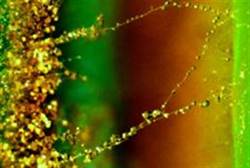
Israeli Researchers Discover Fungi-Bacteria Partners
Israeli researchers at Tel Aviv University have discovered a mutually beneficial relationship between fungi and bacteria that identifies one of the ways in which both are able to spread.
The study, published recently in PNAS, was carried out by Prof. Eshel Ben-Jacob of Tel Aviv University’s Raymond and Beverly Sackler School of Physics and Astronomy. He conducted the research in collaboration with Dr. Colin J. Ingham of Wageningen University and JBZ Hospital in the Netherlands, the paper’s lead author; post-doctoral fellow Dr. Alin Finkelshtein and graduate student Oren Kalishman.
The team’s discovery furthers the understanding of specifically how fungi and bacteria spread, and helps scientists fight disease-causing bacteria, or promote the spread of “good” bacteria or fungi. “We now know that when you fight fungi, you are also fighting bacteria, and vice versa,” notes Ben-Jacob.
Fungal spores can attach themselves to bacteria, “hitching a ride” wherever the bacteria travel, according to the professor.
In turn, the bacteria benefit as well, because they exist largely in the rhizosphere, an environment that surrounds plant roots where air pockets can interrupt their progress.
Ben-Jacob explains that when the bacteria are faced with a gap from an air pocket, they can drop fungal spores to form a bridge, and continue across to the other side, thus continuing to travel on their way.
One of the mobile or “motile” bacteria, called Paenibacillus vortex, are known to be able to carry cargo. The researchers used this form of bacteria to test whether P. vortex could carry non-motile fungi to aid in its distribution — which it did. “The bacteria entrap the spores and wrap them in their flagella, which are like arms,” Ben-Jacob explains. “This is similar to the way the Lilliputians moved the giant Gulliver by trapping him in a mesh of ropes.
When confronted with “canyons” too large to cross, the bacteria used the fungi’s mycelia, or branch-like structures on the spores, in order to form natural bridges to cross. “We see that upon encountering impossible terrains, the bacteria can bring fungal spores to help,” the professor says. “The bacteria allow the fungi to germinate and form a colony, and then use the mycelia to cross obstacles.”
The mechanisms by which the two can help each other invade new territories, including hospitals and the human body, can be applied in agriculture and medicine, according to Ben-Jacob.
“The bacteria never let us down,” he says. “Just present them with a new challenge and you can be sure they’ll provide new surprises.”


